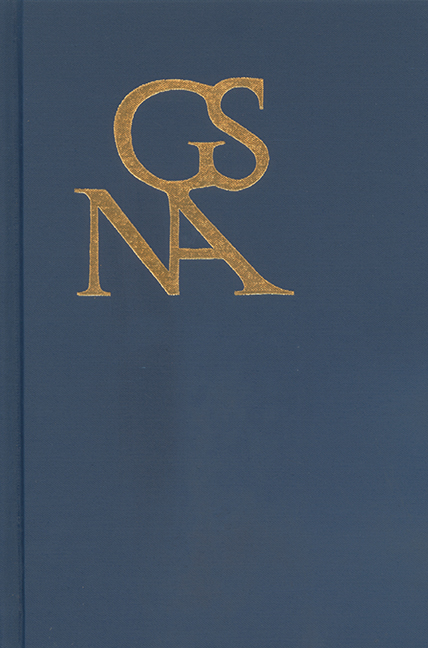Book contents
- Frontmatter
- Contents
- Special Section on Goethe and the Postclassical: Literature, Science, Art, and Philosophy, 1805–1815
- Helena, Then Hell: Faust as Review and Anticipation of Modern Times
- Histrionic Nationality: Implications of the Verse in Faust
- Die Wette in Goethes Faust
- Ecocriticism, the Elements, and the Ascent/Descent into Weather in Goethe's Faust
- Grablegung im Vorhof des Palasts: Groteske Anschaulichkeit in den vorletzten Szenen von Faust II
- Goethes Gnostiker: Fausts vergessener Nihilismus und sein Streben nach Erlösungswissen
- The Unconscious of Nature: Analyzing Disenchantment in Faust I
- Forms of Figuration in Goethe's Faust
- Goethe's Morphology of Knowledge, or the Overgrowth of Nomenclature
- Paraphrasis: Goethe, the Novella, and Forms of Translational Knowledge
- Dramas of Knowledge: The “Fortunate Event” of Recognition
- gegen: Bewegungen durch Goethes “Der Mann von funfzig Jahren”
- “Offenbares Geheimnis” oder “geheime Offenbarung”? Goethes Märchen und die Apokalypse
- Goethe's Green: The “Mixed” Boundary Colors in Zur Farbenlehre
- For Heaven's Sake, I Will Have You Walk into the Dark: Grillparzer's Containment of Beethoven and the Ambivalence of Their Melusina Project
- Imitation, Pleasure, and Aesthetic Education in the Poetics and Comedies of Johann Elias Schlegel
- Feindlich verbündet: Lessing und die Neuen Erweiterungen der Erkenntnis und des Vergnügens
- Juvenalian Satire and the Divided Self in Goethe's “Das Tagebuch”
- Book Reviews
Goethe's Green: The “Mixed” Boundary Colors in Zur Farbenlehre
from Special Section on Goethe and the Postclassical: Literature, Science, Art, and Philosophy, 1805–1815
Published online by Cambridge University Press: 14 March 2018
- Frontmatter
- Contents
- Special Section on Goethe and the Postclassical: Literature, Science, Art, and Philosophy, 1805–1815
- Helena, Then Hell: Faust as Review and Anticipation of Modern Times
- Histrionic Nationality: Implications of the Verse in Faust
- Die Wette in Goethes Faust
- Ecocriticism, the Elements, and the Ascent/Descent into Weather in Goethe's Faust
- Grablegung im Vorhof des Palasts: Groteske Anschaulichkeit in den vorletzten Szenen von Faust II
- Goethes Gnostiker: Fausts vergessener Nihilismus und sein Streben nach Erlösungswissen
- The Unconscious of Nature: Analyzing Disenchantment in Faust I
- Forms of Figuration in Goethe's Faust
- Goethe's Morphology of Knowledge, or the Overgrowth of Nomenclature
- Paraphrasis: Goethe, the Novella, and Forms of Translational Knowledge
- Dramas of Knowledge: The “Fortunate Event” of Recognition
- gegen: Bewegungen durch Goethes “Der Mann von funfzig Jahren”
- “Offenbares Geheimnis” oder “geheime Offenbarung”? Goethes Märchen und die Apokalypse
- Goethe's Green: The “Mixed” Boundary Colors in Zur Farbenlehre
- For Heaven's Sake, I Will Have You Walk into the Dark: Grillparzer's Containment of Beethoven and the Ambivalence of Their Melusina Project
- Imitation, Pleasure, and Aesthetic Education in the Poetics and Comedies of Johann Elias Schlegel
- Feindlich verbündet: Lessing und die Neuen Erweiterungen der Erkenntnis und des Vergnügens
- Juvenalian Satire and the Divided Self in Goethe's “Das Tagebuch”
- Book Reviews
Summary
GOETHE's FIRST LOOK through a prism showed him the colored fringes that became the foundation for his whole theory of color. In his Beiträge zur Optik (1791), he described a series of experiments showing the fringe colors—now usually called boundary colors—produced by looking through a prism at a white strip on a black surface and a black strip on a white surface. The white strip on black gives violet/blue and yellow/orange fringes with white space between. If the viewing distance is increased or the strip is narrowed so that the fringes overlap, blue and yellow eventually give place to green. The remaining sequence is therefore violet / green / orange. The black strip on white gives yellow/orange and violet/blue fringes with black space between. If the strip is narrowed so that the fringes overlap, orange and violet eventually give place to magenta. The remaining sequence is therefore yellow / magenta / blue (see figure 1).
Rupprecht Matthaei, the twentieth century's most knowledgeable writer on Goethe's color theory, argued convincingly that Goethe used the six boundary colors to construct his color circle. The circle's top half consists of the inner boundary colors from the white strip, orange and violet, to left and right, with magenta between them in the center. Its bottom half consists of the inner boundary colors from the black strip, yellow and blue, to left and right, with green between them in the center (see figure 2). Goethe believed that his circle, which joined the two ends of Newton's open, linear spectrum, thus remedied its lack of structure, bringing symmetry into the realm of color. And of course the circle is indeed a closed, continuous arrangement of the colors, complete by construction.
For Goethe, however, it was not so much a colorimetric convenience as a proof of his deepest philosophical and metaphysical beliefs. A dualist in the tradition of Aristotle, he understood color as a product of the opposition between light and darkness. Therefore he saw yellow, the color he considered closest to light, and blue, which was closest to darkness, as a pair of polar opposites fundamental to the world of color.
- Type
- Chapter
- Information
- Goethe Yearbook 17 , pp. 259 - 274Publisher: Boydell & BrewerPrint publication year: 2010



